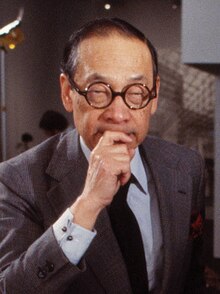Ieoh Ming Pei FAIA RIBA[2] (/ˌjoʊ mɪŋ ˈpeɪ/ YOH ming PAY;[3][4] Chinese: 貝聿銘; pinyin: Bèi Yùmíng; April 26, 1917 – May 16, 2019) was a Chinese-American architect. Born in Guangzhou into a Chinese family, Pei drew inspiration at an early age from the garden villas at Suzhou, the traditional retreat of the scholar-gentry to which his family belonged. In 1935, he moved to the United States and enrolled in the University of Pennsylvania's architecture school, but quickly transferred to the Massachusetts Institute of Technology. Unhappy with the focus on Beaux-Arts architecture at both schools, he spent his free time researching emerging architects, especially Le Corbusier.
After graduating from MIT, Pei enrolled in the Harvard Graduate School of Design (GSD) where he befriended faculty members Walter Gropius and Marcel Breuer, both of whom had formerly taught at the Bauhaus.
Beginning in 1948, Pei worked as an in-house architect for New York City real estate developer William Zeckendorf. In 1955, he established an independent design firm, I. M. Pei & Associates. In 1966, the firm was reorganized as I. M. Pei & Partners, and in 1989 reorganized as Pei Cobb Freed & Partners. Pei retired from full-time practice in 1990. In his retirement, he worked as an architectural consultant primarily with his sons' architectural firm Pei Partnership Architects.
Pei's first major recognition came with the Mesa Laboratory at the National Center for Atmospheric Research in Colorado (designed in 1961, and completed in 1967). His new stature led to his selection as chief architect for the John F. Kennedy Library in Massachusetts. He went on to design Dallas City Hall and the East Building of the National Gallery of Art.[5] He returned to China for the first time in 1975 to design a hotel at Fragrant Hills and, fifteen years later, designed Bank of China Tower, Hong Kong. In the early 1980s, Pei was the focus of controversy when he designed a glass-and-steel pyramid for the Louvre in Paris. He designed the Morton H. Meyerson Symphony Center in Dallas, the Miho Museum in Japan, Shigaraki, near Kyoto, and the chapel of the junior and high school: MIHO Institute of Aesthetics, the Suzhou Museum in Suzhou,[6] Museum of Islamic Art in Qatar, and the Grand Duke Jean Museum of Modern Art in Luxembourg.
Pei won prizes and awards in the field of architecture, including the AIA Gold Medal in 1979, the first Praemium Imperiale for Architecture in 1989, and the Lifetime Achievement Award from the Cooper-Hewitt, National Design Museum, in 2003. In 1983, he won the Pritzker Prize, which is sometimes referred to as the Nobel Prize of architecture.
- ^ "T'ing Chung Pei Obituary". The New York Times. February 2, 2003. Retrieved June 3, 2019.
- ^ I.M. Pei Biography Archived February 18, 2007, at the Wayback Machine – website of Pei Cobb Freed & Partners
- ^ "NLS Other Writings: Say How, M-P". National Library Service for the Blind and Print Disabled. Archived from the original on July 24, 2017.
- ^ "Pei". dictionary.com. Archived from the original on June 2, 2019. Retrieved May 19, 2019.
- ^ Goldberger, Paul (May 16, 2019). "I.M. Pei, Master Architect Whose Buildings Dazzled the World, Dies at 102". The New York Times. Retrieved May 17, 2019.
- ^ "Suzhou Museum – Suzhou". my-travel-in-china.com. Archived from the original on March 21, 2019. Retrieved March 21, 2019.
